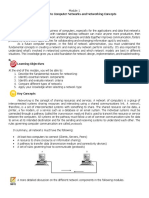0% found this document useful (0 votes)
287 views6 pagesComputer Network & Security Basics
This document provides an overview of computer networks and network security. It begins with defining what a computer network is and discussing the importance and historical development of networks. It then covers key network topics like types of networks, components, topologies, and protocols. The document also defines network security, discusses common threats, and outlines security best practices. The overall purpose is to introduce both computer networks and network security at a high level.
Uploaded by
Eldrian G. SantosCopyright
© © All Rights Reserved
We take content rights seriously. If you suspect this is your content, claim it here.
Available Formats
Download as DOCX, PDF, TXT or read online on Scribd
0% found this document useful (0 votes)
287 views6 pagesComputer Network & Security Basics
This document provides an overview of computer networks and network security. It begins with defining what a computer network is and discussing the importance and historical development of networks. It then covers key network topics like types of networks, components, topologies, and protocols. The document also defines network security, discusses common threats, and outlines security best practices. The overall purpose is to introduce both computer networks and network security at a high level.
Uploaded by
Eldrian G. SantosCopyright
© © All Rights Reserved
We take content rights seriously. If you suspect this is your content, claim it here.
Available Formats
Download as DOCX, PDF, TXT or read online on Scribd
/ 6

























































































